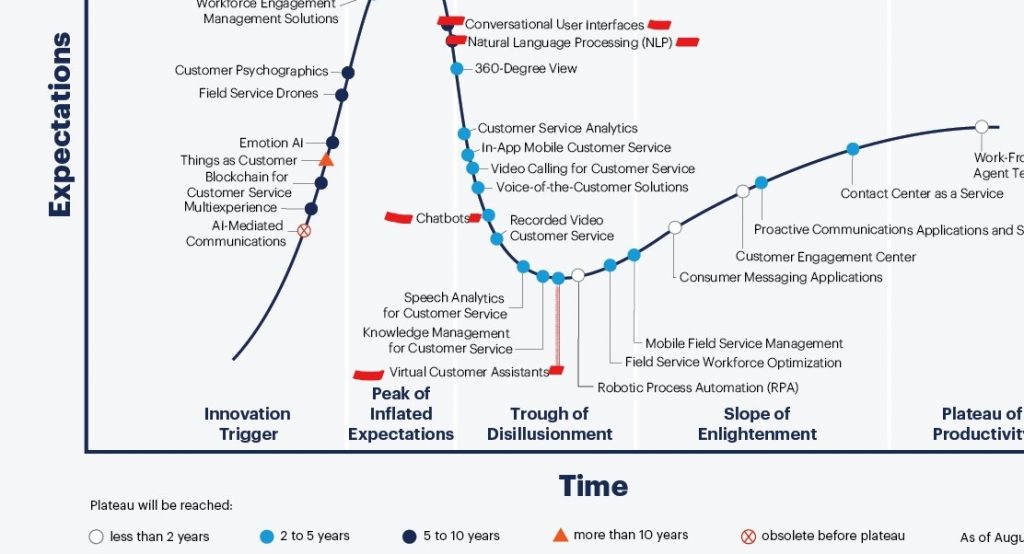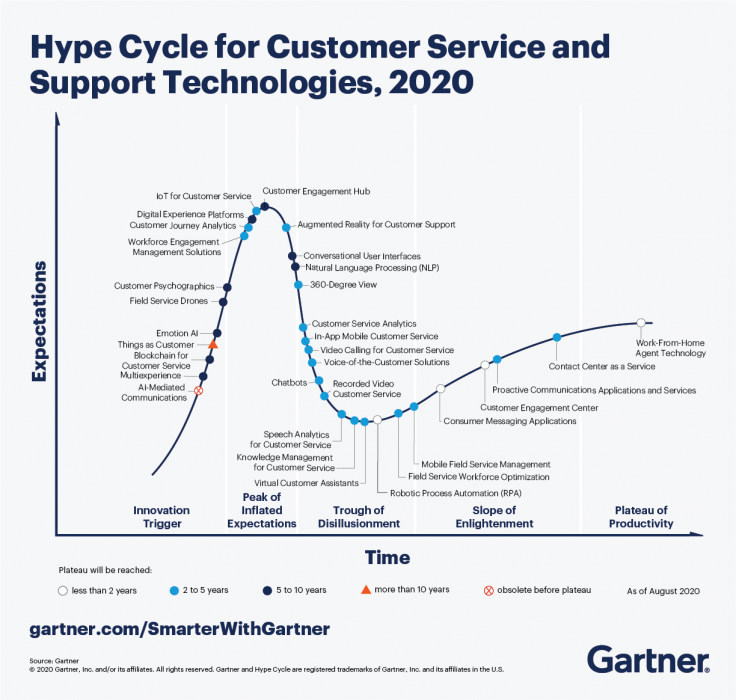A great customer experience (CX) is at the core of every leading organization. To achieve this goal, companies use diverse technologies. Examples of customer service and support technologies include Voice and Chatbot solutions. However, how does each technology contribute to the customer experience goals?
The Gartner Hype Cycle for Customer Service and Support 2020 identified 33 key technologies for giving customer support, describing the maturity of each one. In this article, we’ll focus on the analysis of the four key Chatbot and Virtual Assistant technologies. In this post you’ll learn:
- Overview of the Gartner’s Hype Cycle Report
- Virtual Customer Assistants
- Chatbots
- Conversational User Interfaces
- Natural Language Processing
- What’s Next for Voice and Chatbot Strategies?
What is the Gartner’s Hype Cycle Report?
The goal of the report is to analyse the evolution of new technology. How do you know a new application of technology is commercially viable and not just a hype?
The hype cycle methodology compares the promise of an emerging technology versus the reality of its adoption.
The hype cycles report identifies four different stages in the evolution of emergent technology:
- Innovation trigger – the start of breakthrough technology. At this stage, the early prototypes and the media create expectations and buzz about the new application. There is no proof of commercial viability.
- Peak of inflated expectations- the increase in publicity creates a peak of interest fueled by success stories. The failures are often overlooked.
- Trough of disillusionment- the failures are more noticeable and produce a decrease in interest. At this point, the producers of the technology improve it or fail. If the improvements satisfy the expectations of early adopters, the technology passes to the next stage.
- Slope of enlightenment- thanks to the improvements, technology becomes more popular. Second and third-generation products appear.
- Plateau of productivity- start of mainstream adoption. The product reaches maturity and companies can detect viable providers.
Companies use Hype Cycles to evaluate the viability of investing in growing technology. You can identify what drives a technology’s commercial promise, reducing the risk for your technology investment decisions.
What Is the Meaning of the Hype Cycle for Customer Support Technologies?
“The Hype Cycle document is targeted at application leaders tasked with helping business units select and deploy emerging customer service and support (CSS) technologies. “(Gartner)
The 2020 edition of the report is marked by the changes brought by the COVID-19 pandemic. This year’s cycle presents a marked focus on functionality and customer experience for customer support technologies.
The report analysed 33 different customer support technologies in various stages of evolution. In the next section, we are going to review four technologies within this year’s hype cycle near maturity, proving their viability as technology investments. Let’s explore.

Virtual Customer Assistants
A virtual customer assistant (VCA) is a software package that interacts and provides assistance to customers on behalf of an organization. They differ from chatbots in that they keep customer information creating relationships with customers. Voice assistants are used especially in banking and contact centers, avoiding the need to type to navigate the system.
Status in the hype cycle – are in the lowest point of the through. This means the objections and issues with voice assistant technology are solved and it will start climbing the slope to mainstream adoption.
Chatbots
Gartner defines a chatbot as a domain-specific conversational interface that uses an app, message platform, social network of chat solutions for its conversations.
Chatbot solutions can range from simple logic-tree conversations to AI solutions based on Natural Language Processing and Machine Learning. Chatbots had a key role in companies’ responses to COVID-19.
Status in the hype cycle – chatbots already passed the peak of expectations, probably because of the increase in use during the pandemic. According to the report, chatbots are expected to have a 100% increase in adoption in the next 2-5 years ahead before reaching a plateau of productivity. The technology increased from 20% to 50% adoption since last year.
Conversational User Interfaces
Conversational Interfaces (CUI) are computer user interfaces that mimic human conversation. They give the user a chance to interact with the computer in their natural language. Along with speech recognition and virtual assistants, Gartner includes CUIs in the hype cycle for natural language technologies.
Status in the hype cycle – Conversational User Interfaces has just come off the peak, with increased adoption. The focus on customer experience makes the ability to interact naturally as a key part of a conversational technology solution.
Natural Language Processing
Natural Language Processing is a subfield of artificial intelligence (AI) which concerns the computerized analysis and processing of natural language data. Online assistants and AI-powered chatbots use natural language processing to understand and answer user queries.
Status in the hype cycle- it is just off the peak of inflated expectations. The rapid demand created situations when customers had unmet expectations. At Pure Speech Technology, we meet customers’ expectations for the last 17 years, working with NLP. PST Intent Manager provides the accuracy, relevance, and business functionality that gives your customers a natural and great user experience.
What’s Next for your Voice, Chatbot, and NLP Strategies?
According to the Capgemini report, conversational assistants are going mainstream. Companies consider chatbot and voice assistants a key feature for customer engagement and user experience.
Why is this chart important? The updated 2020 hype cycle shows a maturation for Virtual Customer Assistants ready to take off through the slope of enlightenment. Chatbots and NLP aren’t far behind, and more so reflects the newer channels in which you find the same underpinning conversational technology: Facebook Messenger, WhatsApp, etc. With an explosion of hype around Chatbots and NLP, there are bound to be new players who fumble at the start line.
What we think. Here are some pointers for companies looking to bring a step change to their customer conversation strategy:
- Leverage lessons learned from the early adopters/innovators. Read up on people’s battle scars or join practitioner communities. The leading sectors adopting conversational technology were automotive, retail banking, insurance, and telcos. Automotive companies adopted voice assistants to help drivers control the vehicles and access concierge functions. Banking and insurance were the top adopters of chatbots, streamlining processes, and customer services. For instance, Scandinavian banks Nordea and DNB turned to AI-driven chatbots, automating more than half of customer queries. This enhanced customer interactions, allowing the banks to attend to thousands of queries daily. You can also find examples of VCAs in Australian banks: Nab, Westpac, Commbank.
- Plan your post-covid intelligent customer service strategy to take off. Now is the moment to re-define your customer service engagement for the post-pandemic world. Consumers are shifting to digital, and demand more immediate answers 24/7 in a natural and personalised manner… Chatbots and Voice Assistants can provide that.
- Prepare your team to execute your customer service strategy. Gain funding, get training for your team, identify and select vendors that can help you achieve your business goals.
How you can partner with Pure Speech Technology on your Voice and Chatbot Strategy
The PST team consists of conversational AI experts backed with nearly 2 decades of experience dedicated to Voice and Chatbot automation (where else can you find that much experience?). PST aims to empower organisations to adopt Voice and Chatbot technologies in their customer strategy. We’ll partner with you to:
- Consult on strategy and business case development to plan for success
- Train new Chatbot product owners or conversational designers
- Build Voice or Chatbot solutions to achieve the business outcome
- Fix poor performing NLP engines to deliver ROI
Leverage the power of AI conversational technologies for your customer support and service. Get in touch and let’s create something great together.
